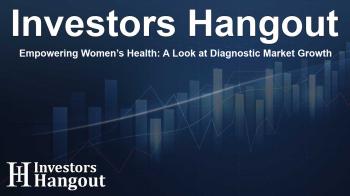Empowering Women’s Health: A Look at Diagnostic Market Growth

Women's Health Diagnostics Market Size & Growth Insights
The Women's Health Diagnostics Market is experiencing significant growth, with projections indicating an increase from USD 25.30 billion in 2023 to USD 49.00 billion by 2032. Analysts expect this market to expand at a CAGR of 7.64% from 2024 to 2032. This growth can be attributed to heightened awareness surrounding women's health issues, substantial technological advancements in diagnostic methods, and the rising occurrence of chronic and lifestyle-related illnesses among women.
Technological Advances Boosting the Market
Innovations in areas such as genetic testing, imaging technologies, and biomarker research are revolutionizing how vital health conditions like breast cancer, cervical cancer, and reproductive health disorders are diagnosed and treated. These technological breakthroughs enable earlier detection, ensuring timely interventions that are crucial for successful health outcomes.
Importance of Early Detection
With an alarming rise in the prevalence of diseases such as breast cancer and cervical cancer, the demand for accurate and efficient diagnostic solutions is paramount. In the United States alone, over 300,000 new breast cancer cases are reported annually. Efforts to heighten awareness of these conditions, coupled with government initiatives aimed at promoting health screenings, are instrumental in facilitating access to early diagnostic tools.
Market Dynamics and Key Drivers
Increased healthcare expenditure, alongside government efforts to elevate women's health programs, plays a key role in driving growth in the diagnostics sector. The U.S. maintained a substantial 38% share of the global market in 2023, largely due to its strong healthcare infrastructure and various government-backed initiatives, such as the National Breast and Cervical Cancer Early Detection Program.
Challenges Facing the Market
Despite the positive growth trajectory, challenges remain. High diagnostic costs and barriers to healthcare access in certain regions could impede progress. Additionally, cultural factors may discourage women from seeking necessary screenings, further complicating the landscape of women’s health diagnostics.
Key Players in Women's Health Diagnostics
Leading companies within the Women’s Health Diagnostics sector are instrumental in shaping market trends. Key players include F. Hoffmann-La Roche Ltd., Hologic, Quest Diagnostics Incorporated, and Abbott, among others. Each of these companies offers innovative testing solutions to address various health concerns, from HPV and breast cancer screening to advanced imaging techniques.
Company Innovations
These leading firms are investing in the research and development of cutting-edge technologies. For instance, advancements such as liquid biopsies and AI-enhanced imaging systems enhance diagnostic precision and accessibility. Additionally, the rise of mobile health solutions has given women more convenient options for monitoring their health.
Regional Market Insights
North America leads the global market with approximately 44.31% of the total revenue in 2023. Factors contributing to this dominance include high healthcare spending, robust diagnostic infrastructures, and numerous government programs designed to enhance cancer screening and diagnosis. Europe and the Asia-Pacific regions are also emerging areas, with growing investments and increasing health awareness driving diagnostics solutions forward.
Educational Awareness and Advocacy
Cultural awareness and educational initiatives are pivotal in driving women to pursue regular screenings. Advocacy groups and digital health platforms play critical roles in propelling this awareness, ensuring that women understand the importance of early detection and timely treatment.
Addressing the Future of Women’s Health Diagnostics
As the market continues to evolve, it is anticipated that more women will gain access to advanced diagnostic solutions, thanks to ongoing innovations and increased societal focus on health. Efforts aimed at eliminating disparities in healthcare access and reducing the costs associated with diagnostic testing will be essential in continuing this positive momentum.
Frequently Asked Questions
What is the Women's Health Diagnostics Market projected to reach by 2032?
The Women's Health Diagnostics Market is expected to grow to USD 49.00 billion by 2032.
What factors are driving the growth of this market?
Factors include increased awareness of women's health issues, advancements in diagnostic technologies, and the rising prevalence of chronic diseases among women.
Who are the major players in the Women's Health Diagnostics market?
Some major players include F. Hoffmann-La Roche Ltd., Hologic, Quest Diagnostics Incorporated, and Abbott.
What challenges does the Women's Health Diagnostics market face?
Challenges include high diagnostic costs, disparities in healthcare access, and cultural barriers that may prevent women from seeking necessary screenings.
How does technological innovation impact this market?
Technological innovations, such as AI and genetic testing, significantly improve diagnostic accuracy and accessibility, facilitating early detection and treatment.
About The Author
Contact Evelyn Baker privately here. Or send an email with ATTN: Evelyn Baker as the subject to contact@investorshangout.com.
About Investors Hangout
Investors Hangout is a leading online stock forum for financial discussion and learning, offering a wide range of free tools and resources. It draws in traders of all levels, who exchange market knowledge, investigate trading tactics, and keep an eye on industry developments in real time. Featuring financial articles, stock message boards, quotes, charts, company profiles, and live news updates. Through cooperative learning and a wealth of informational resources, it helps users from novices creating their first portfolios to experts honing their techniques. Join Investors Hangout today: https://investorshangout.com/
The content of this article is based on factual, publicly available information and does not represent legal, financial, or investment advice. Investors Hangout does not offer financial advice, and the author is not a licensed financial advisor. Consult a qualified advisor before making any financial or investment decisions based on this article. This article should not be considered advice to purchase, sell, or hold any securities or other investments. If any of the material provided here is inaccurate, please contact us for corrections.

